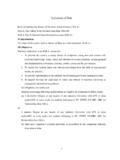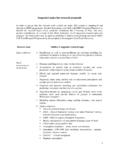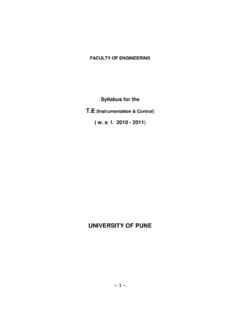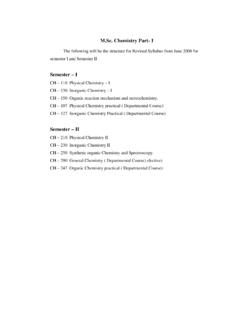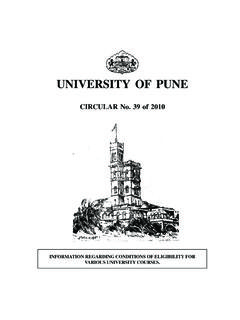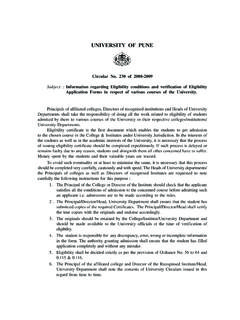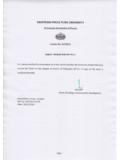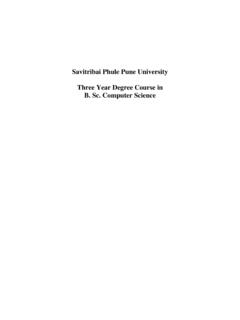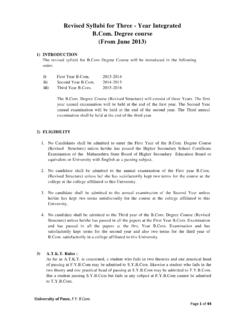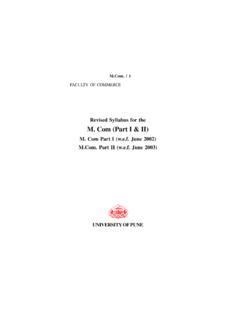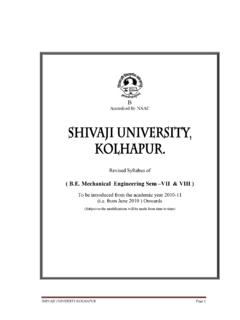Transcription of (Page 1) Draft of M.Sc Botany Syllabus : Course …
1 (Page 1). Draft of Botany Syllabus : Course structure Part I (To be Implemented from June 2008). First Semester Course No. Course Titles Lectures/Practicals BO Systematics of non-vascular plants 48 Lectures BO Plant Physiology and Biochemistry 48 Lectures BO Genetics and Plant Breeding 48 Lectures BO Practicals based on BO 24 Practicals BO Practicals based on BO and BO 24 Practicals Second Semester Course No. Course Titles Lectures/Practicals BO Systematics of Vascular Plants 48 Lectures BO Cell Biology and Instrumentation 48 Lectures BO Molecular Biology and Genetic Engineering 48 Lectures BO Practicals based on BO 24 Practicals BO Practicals based on BO and BO 24 Practicals Part II (To be Implemented from June 2009). Third Semester Course No. Course Titles Lectures/Practicals BO Developmental Botany and Plant Tissue Culture 48 Lectures BO Environmental Botany and Palaeobotany 48 Lectures BO to BO Elective Paper I 48 Lectures BO Algology BO Mycology BO Angiosperms BO Plant Physiology (Page 2).
2 BO Pharmacognosy BO Cytogenetics and Plant Breeding BO Plant Ecology BO Plant Biotechnology BO Plant Diversity BO Practicals based on BO and BO 24 Practicals BO Practicals based on Elective paper I (60 Marks) + 18 Practicals + 06. Project Review of 5 Research papers from Reputed Practicals (based on journal (10 Marks) + Seminar based on project review). reviews (10 Marks). Fourth Semester Course No. Course Titles Lectures/Practicals BO Plant diversity, resource utilization and 48 Lectures conservation BO to Elective Papers - II 48 Lectures BO Seed Technology 48 Lectures BO Post harvest Technology BO Natural Plant Products BO Plant Biomass Production BO Plant Pathology BO Plant Protection BO Restoration Ecology BO Plant Improvement BO Bio-statistics and Bioinformatics 48 Lectures BO Practicals based on BO and BO 24 Practicals BO Practicals based on Elective papers II BO to 12 Practicals BO (50 Marks).
3 + Project Work (20 Marks) 10 Practicals + Seminar based on project work (10 Marks) 02 Practicals (Page 3). BO Systematics of Non-Vascular Plants (48 Lectures). 1. INTRODUCTION: - (4 Lectures). Difference in Systematics and Taxonomy, Systematics Concept, structural, Biochemical and Molecular systematics, Principles and Procedures of plant systematics, Sources of data for plant systematics. 2. ALGAE: - (12 Lectures). a. Introduction: - (3 Lectures). Position of algae in eight kingdom system, algal habitats, reserve food, thallus organization, pigments, evolutionary trends among algae, algal classification as per Smith, Fritsch, Bold and Wyne and Christensen. b. Cyanophyta: - (2 Lectures). Cell organization, thallus type, asexual reproduction, heterocyst interrelationships. c. Chlorophyta and Charophyta: - (6 Lectures). Range of thallus, asexual reproduction, life cycle pattern with respect to orders.
4 D. Phaeophyta and Rhodophyta: - (4 Lectures). Thallus organization, asexual and sexual reproduction, interrelationship. e. Minor groups: - (1 Lecture). Chrysophyta, Pyrrophyta. 3. FUNGI: - (16 Lectures). a. Introduction: - (2 Lectures). Present status of fungi, habit or modes of life, Thallus organization, Nutrition-Saprotrophs, Biotrophs, Necrotrophs, Symbiotrophs, Evolutionary trends among fungi. (Page 4). b. Reproduction: - (3 Lectures). Asexual, Sexual methods, Evolution of sex in fungi, Heterothallism, Parasexuality and compatibility, fungal sex hormones. c. Classification: - (1 Lecture). Outline classification of fungi as per Smith, Ainsworth , Alexopoulos, Mims and Blackwell. d. Comparative account of thallus structure and spore producing organs, interrelationship, life cycle pattern and phylogeny of the following groups Myxomycotina, Mastigomycotina, Zygomycotina, Ascomycotina, Basidiomycotina and Deuteromycotina.
5 (10 Lectures). 4. BRYOPHYTA: - (12 Lectures). a. Introduction: - (2 Lectures). Habit and Habitat, Distribution, Outline classification of Bryophytes as per Smith and Watson, Indian Bryology. b. Morphology and anatomy of vegetative and reproductive structures of the following (9 Lectures). Sphaerocarples, Marchantiales, Jungermanniales (Acrogynae, Unacrogynae), Calobryales, Takakiales, Anthocerotales, Sphagnales, Andracales, Polytrichales, Funariales, Dawsoniales. c. Ecological significance of Bryophytes. (1 Lectures). References: - 1. Parihar 1991. Bryophyta. Central Book Depot, Allahabad. 2. Puri P. 1980. Bryophytes. Atma Ram and Sons, Delhi. 3. Alexopoulus , Mims and Blackwel 1996. Introductory Mycology. John Wiley and Sons Inc. 4. Kumar 1988. Introductory Phycology. Affiliated East-West Press Ltd., New Delhi. 5. Mehrotra and Aneja 1998. An introduction to Mycology. New Age Intermediate Press.
6 6. Morries I 1986. An Introduction to the Algae. Cambridge University Press, (Page 5). 7. Rangaswamy G. and Mahadevan A. 1999. Diseases of crop plants in India (Fourth Edition) Prentice Hall of India Pvt. Ltd. New Delhi. 8. Round 1986. The Biology of Algae. Cambridge University Press, Cambridge. 9. Webster J. 1985. Introduction to Fungi. Cambridge University Press. 10. Hawker 1967. An Introduction to Fungi Cambridge. 11. Vashista & Sinha 2005. Botany for degree students Algae, Publication. 12. Kamat 1959. Hand Book of Mycology, Prakash Publication. 13. Vashista & Sinha 2005. Botany for degree students Fungi, Publication. 14. Vashista & Sinha 2005. Botany for degree students Bryophta, Publication 15. Ainsnorth 1973. The Fungi Vol IV A, IV B Academic Press. 16. Bessey 1950. Morphology and Taxonomy of fungi. The Blakistan Co. 17. Burnett 1968. Fundamentals of Mycology. Edwards Arnold Publication.
7 18. Vijayraghavan and Bela Bhatia (1997), Red Algae : structure , ultrastructure and Reproduction, APH publishing Corporations, New Delhi. 19. Vijayraghavan and Bela Bhatia (1997), Brown Algae : structure , ultrastructure and Reproduction, APH publishing Corporations, New Delhi. 20. Fritsch (1945). The structure and reproduction of the algae Volume I and II, Cambridge University Press. 21. Chapman and Chapman (1973). Thje Algae Macmillon and company, New York. 22. Bold and Wynne (1975). Introduction to the Algae structure and reproduction prentice hall Biological Science Series. 23. Sporne. Morphology of Bryophytes, Oxford Publishing House. 24. Pandey A Text-book of Botany Volume I, Vikas Publications. 25. Rashid A (1998). An introduction to Bryophyta. First edition, Vikas Publishing House Pvt. Ltd, New Delhi. 26. Chandrakant Pathak (2003) First Edition. Bryophyta, Dominant Publishers and Distributors, New Delhi.
8 (Page 6). BO Plant Physiology and Biochemistry (48 Lectures). PLANT PHYSIOLOGY: - (24 Lectures). 1. Plant Water Relation: - (3 Lectures). Regulation of water supply, Aquaporins and facilitated water Transport, Soil plant atmosphere continuum (SPAC), Recent concept in stomatal physiology, Signal transdution in guard cell. 2. Solute Transport: - (3 Lectures). Diffusion, Nerst equation, Uniport, Symport, Antiportion channels, ATP driven active transport (Phloem loading and unloading). 3. Photochemistry and Photosynthesis: - (5 Lectures). Photosynthetic pigments, absorption and transformation of radiant energy, Light harvesting complexes, Kok curve, Kautsky curve, ETS, photo inhibition O2 and H2 evolution, Regulation of Calvin cycle, RUBISCO. activity, Photorespiration, CAM, C4 Pathway. 4. Respiration: - (4 Lectures). Overview of plant Respiration, EMP pathway, TCA cycle, PPP, Glyoxylate cycle, Mitochondrial ETS, Cyanide resistance pathway, Gluconeogenesis, High energy compounds: Synthesis and utilization, ATP synthesis.
9 5. Plant growth regulators: - (3 Lectures). Biosynthesis and action mechanism of : Auxins Gibberellins, (GA), Cytokinins, Ethylene, Abscicsic Acid, Introduction of other hormones. 6. Seed Germination, Flowering and Fruit ripening: - (4 Lectures). Metabolic changes during seed germination, flowering initiation, maturity and fruiting, fruit ripening. 7. Stress Physiology: - (2 Lectures). Biotic and abiotic stresses. (Page 7). BIOCHEMISTRY: - (24 Lectures). 1. Energy Dynamics: - (2 Lectures). structure of atoms, molecules and chemical bonds, principles of physical chemistry, principles of thermodynamics, free energy, Redox potentials, Dissociation and associations constants, Activation energy, Binding energy. 2. Enzymology: - (4 Lectures). General classification of Allosteric mechanism, Isozymes, Factors affecting enzyme activity, Enzyme Kinetics, Michaelis Menton equation, Competitive, uncompetitive and non competitive inhibition.
10 3. Carbohydrates: - (4 Lectures). General classification, Synthesis and breakdown of carbohydrates (starch, glycogen, pectin, Glucose). 4. Amino acids and proteins: - (4 Lectures). General classification of amino acids and proteins, structure , synthesis and properties of amino acids, protein structure (Primary, secondary, tertiary and quaternary), Ramchandran plot. 5. Nitrogen metabolism: - (2 Lectures). Nitrogen uptake, NOD factor, root nodulation and nitrogen fixation. 6. Secondary metabolites: - (5 Lectures). General classification of Major pathways, Phenolics (Lignins, tannins). Flavonoids, terpenoids (steroids), Alkaloids, pigments (Carotenoids, Anthocynins). 7. Lipid metabolism: - (3 Lectures). General classification of Phospho, Spingo, Glyco Lipid biosynthesis and oxidation. (Page 8). References: - 1. Buchanan , Gruissem W. and Jones 2000. Biochemistry and Molecular Biology of Plants. American Society of Plant Physiologistsm Maryland, USA.
